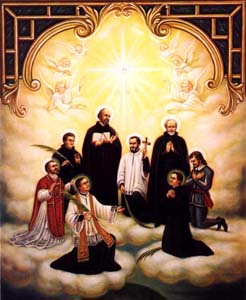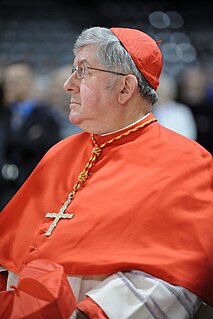
Prescott, Ontario is a small town on the north shore of the Saint Lawrence River in the United Counties of Leeds and Grenville, Canada. In 2016, the town had a population of 3,965. The Ogdensburg–Prescott International Bridge, 5 kilometres (3.1 mi) east of Prescott at Johnstown, connects the town with Ogdensburg, New York. The town is about an hour from both Ottawa and Kingston.

The Canadian Martyrs, also known as the North American Martyrs, were eight Jesuit missionaries from Sainte-Marie among the Hurons. They were ritually tortured and killed on various dates in the mid-17th century in Canada, in what is now southern Ontario, and in upstate New York, during the warfare between the Iroquois and the Huron. They have subsequently been canonized and venerated as martyrs by the Catholic Church.

The Canadian Catholic Church, or Catholic Church in Canada, is part of the worldwide Catholic Church, and has a decentralised structure, meaning each diocesan Bishop is autonomous but under the spiritual leadership of the Pope and the Canadian Conference of Catholic Bishops. As of 2011, it has the largest number of adherents to a Christian denomination and a religion in Canada, with 38.7% of Canadians being adherents according to the census in 2011. There are 73 dioceses and about 7,000 priests in Canada. On a normal Sunday, between 15 and 25 per cent of Canada's Catholics attend Mass.
In Canada, a separate school is a type of school that has constitutional status in three provinces and statutory status in the three territories. In these Canadian jurisdictions, a separate school is one operated by a civil authority—a separate school board—with a mandate enshrined in the Canadian Constitution or in federal statutes. In these six jurisdictions a civil electorate, composed of the members of the minority faith, elects separate school trustees according to the province's or territory's local authorities election legislation. These trustees are legally accountable to their electorate and to the provincial or territorial government. No church has a constitutional, legal, or proprietary interest in a separate school.
Religion in Canada encompasses a wide range of groups and beliefs. Christianity is the largest religion in Canada, with Roman Catholics having the most adherents. Christians, representing 67.2% of the population in 2011, are followed by people having no religion with 23.9% of the total population. Other faiths include Islam (3.2%), Hindus (1.5%), Sikhs (1.4%), Buddhists (1.1%), and Jews (1.0%). Rates of religious adherence are steadily decreasing. The preamble to the Canadian Charter of Rights and Freedoms refers to God. The monarch carries the title of "Defender of the Faith". However, Canada has no official religion, and support for religious pluralism and freedom of religion is an important part of Canada's political culture.

Irish Canadians are Canadian citizens who have full or partial Irish heritage including descendants who trace their ancestry to immigrants who originated in Ireland. 1.2 million Irish immigrants arrived from 1825 to 1970, and at least half of those in the period from 1831 to 1850. By 1867, they were the second largest ethnic group, and comprised 24% of Canada's population. The 1931 national census counted 1,230,000 Canadians of Irish descent, half of whom lived in Ontario. About one-third were Catholic in 1931 and two-thirds Protestant.

South Glengarry is a township in eastern Ontario, Canada on the Saint Lawrence River in the United Counties of Stormont, Dundas and Glengarry. South Glengarry borders Quebec.

Angela Merici or Angela de Merici was an Italian religious educator, who is honored as a saint by the Roman Catholic Church. She founded the Company of St. Ursula in 1535 in Brescia, in which women dedicated their lives to the service of the Church through the education of girls. From this organisation later sprang the monastic Order of Ursulines, whose nuns established places of prayer and learning throughout Europe and, later, worldwide, most notably in North America.
Croatian Canadians are Canadian citizens who are of Croatian descent. The community exists in major cities including the Greater Toronto Area, Hamilton, Ottawa, Vancouver, Calgary, Edmonton, Winnipeg, Windsor, Montreal and Waterloo Region.
Hungarian Canadians are persons in Canada of Hungarian ancestry. According to the 2016 Census, there are 348,085 Canadians of Hungarian ancestry. The Hungarian minority is the 24th largest ethnic group of Canada. The bulk of Hungarian immigration occurred after World War II, with the wave peaking after the 1956 Hungarian revolution against communist rule, when over 100,000 Hungarian refugees went to Canada. The Hungarian Canadian community is among the country's multiple ethnicities; Canada is one of the top five countries of the Hungarian diaspora.

Niagara is a neighbourhood in Toronto, Ontario, Canada, located south of Queen Street West; it is usually bordered by Strachan Avenue to the west, Bathurst Street to the east, and the railway corridor to the south, and so named because Niagara Street runs through the centre of it. The eastern portion of this area was first planned as the New Town Extension when Toronto was incorporated as a city. The area was developed as a residential area for the workers of industries located along the CN and CP railway corridors. It remains a working-class neighbourhood that has seen the development of new condominium apartment buildings.
Jules C. E. Riotte, was a priest of the Ukrainian Catholic Eparchy of Saint Nicholas in Chicago, and a researcher at the Bernice Pauahi Bishop Museum in Honolulu. He was born in Dresden, Germany of mixed French and Lusatian Sorb heritage. During the Second World War, he was active in the resistance movement against the Nazis and he was briefly interned in the Sachsenhausen concentration camp. As a POW he was sent to Great Britain and worked for the British Broadcasting Corporation as a translator of German and Slavic languages.
The Liberal Catholic Church of Ontario (LCCO) was a non-theosophical Liberal Catholic denomination in Canada, now merged into the Christ Catholic Church International, which formed in 1991. The LCCO grew out of the Old Catholic Diocese of Hamilton in 1949 by William Henry Daw, who was appointed LCCO's first bishop in 1955.

The Archdiocese of Toronto is a Roman Catholic archdiocese that includes part of the Province of Ontario. Its archbishop is also the ecclesiastical provincial for the dioceses of Hamilton, London, Saint Catharines, and Thunder Bay. The Archbishop is Cardinal Thomas Christopher Collins.

Thomas Christopher Collins is a Canadian cardinal of the Catholic Church. He has been the Archbishop of Toronto since 2007. He was previously Bishop of Saint Paul in Alberta from 1997 to 1999 and Archbishop of Edmonton from 1999 to 2006. Pope Benedict XVI made him a cardinal on 18 February 2012.

Christianity is the most adhered to religion in Canada, with 67.3% of Canadians identifying themselves as of the 2011 census. The preamble to the Canadian Charter of Rights and Freedoms refers to God. The monarch carries the title of "Defender of the Faith". The French colonization beginning in the 17th century established a Roman Catholic francophone population in New France, especially Acadia and Lower Canada. British colonization brought waves of Anglicans and other Protestants to Upper Canada, now Ontario. The Russian Empire spread Orthodox Christianity in a small extent to the tribes in the far north and western coasts, particularly hyperborean nomadics like the Inuit. Orthodoxy would arrive in mainland Canada with immigrants from the eastern and southern Austro-Hungarian Empire and western Russian Empire starting in the 1890s; then refugees from the Soviet Union, Eastern Bloc, Greece and elsewhere during the last half of the 20th century.
Catholic Church sexual abuse cases in Canada are well documented dating back to the 1960s. The preponderance of criminal cases with Canadian Catholic dioceses named as defendants that have surfaced since the 1980s strongly indicate that these cases were far more widespread than previously believed. While recent media reports have centred on Newfoundland dioceses, there have been reported cases—tested in court with criminal convictions—in almost all Canadian provinces. Sexual assault is the act of an individual touching another individual sexually and/or committing sexual activities forcefully and/or without the other person's consent. The phrase Catholic sexual abuse cases refers to acts of sexual abuse, typically child sexual abuse, by members of authority in the Catholic church, such as priests. Such cases have been occurring sporadically since the 11th century in Catholic churches around the world. This article summarizes some of the most notable Catholic sexual abuse cases in Canadian provinces.

Joseph Connolly (1840–1904) was an Irish Canadian architect, born in Limerick, Ireland. He trained as an architect under James Joseph McCarthy in his native Ireland before coming to North America. Connolly specialized in Gothic Revival architecture. He is known for the churches he designed throughout Ontario, mainly for the Irish Roman Catholic community, though he also produced some industrial and residential buildings.
The following outline is provided as an overview of and topical guide to Toronto:

Anishinabe Spiritual Centre is a Roman Catholic centre for Ignatian spirituality and training in ministry run by the Society of Jesus in Espanola, Ontario, specifically for the local First Nation people in the area. It is situated to the south of Espanola, on the shore of Anderson Lake, just off Ontario Highway 6. Since it was founded, it has been the only place in northern Ontario that has offered Roman Catholic ministerial training to Aboriginal peoples in Canada.











